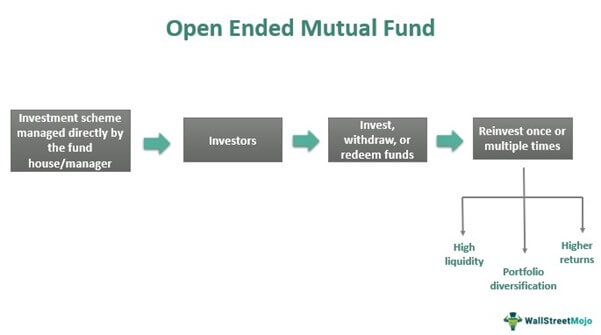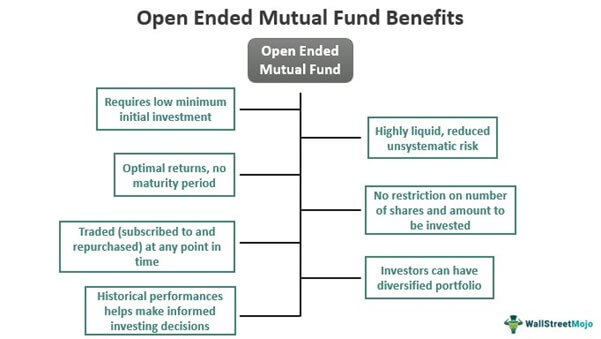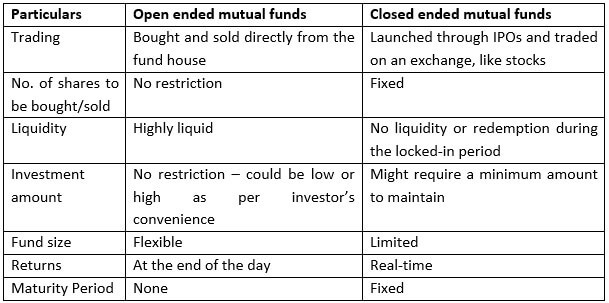What Is Open Ended Mutual Fund?
An open ended mutual fund allows investors to invest, withdraw or redeem their investments on any business day. The net asset value (NAV) per unit can be used to buy shares directly from the fund. This investment instrument tends to be the best alternative for those looking for intermittent liquidity, portfolio diversification, and higher returns.
It acts as a diversified portfolio in which a group of investors with particular investment objectives pool their money to trade an infinite number of shares. It provides flexibility in terms of investment time and the amount and can issue or redeem shares all the time. The fund, however, does not trade in the open market and is priced daily, unlike the closed-ended fund.
Table of contents

You are free to use this image on your website, templates, etc, Please provide us with an attribution linkHow to Provide Attribution?Article Link to be Hyperlinked
For eg:
Source: Open Ended Mutual Fund (wallstreetmojo.com)
Key Takeaways
- An open ended mutual fund is a financial vehicle with a wide range of possibilities, allowing investors to invest, withdraw, or redeem their money at any time throughout the business day.
- It is priced daily depending on the net asset value (NAV) per share bought directly from the fund manager.
- This investment product is often ideal for individuals seeking high liquidity, portfolio diversification, and better returns.
- Unlike a closed ended fund, it does not trade on the exchange, has no restrictions on the number of shares or the amount that can be invested, has no maturity period, and can issue or redeem shares at any time.
Open Ended Mutual Fund Explained
An open ended mutual fund means investors can trade any number of shares for any sum continuously. It, thus, gives them the freedom to enter or exit the fund at any moment. Therefore, it is ideal for those seeking high liquidity, portfolio diversity, and optimal profits. Moreover, the accessibility offered by this sort of fund lets investors invest, withdraw, redeem, or reinvest several times. Besides mutual funds, exchange-traded and hedge funds are examples of it.
Instead of existing shareholders (as in closed ended funds), open ended funds are controlled by the fund manager, from whom investors can purchase shares. There is no particular maturity period and can be subscribed to and repurchased at any time. Furthermore, there are no limitations on the number of shares a fund can issue to investors. Also, they can trade shares at NAV of the fund’s underlying securities per share. The practice of pooling money in diverse assets, on the other hand, necessitates a large cash reserve from investors.

You are free to use this image on your website, templates, etc, Please provide us with an attribution linkHow to Provide Attribution?Article Link to be Hyperlinked
For eg:
Source: Open Ended Mutual Fund (wallstreetmojo.com)
An open ended mutual fund is priced depending on the NAV of shares calculated daily. The NAV fluctuates every day due to changes in the price of shares, and so does the fund’s value. Therefore, investors only interested in liquidity are more likely to invest in open ended funds. However, they may have to pay a fee for purchasing shares.
Money managers can evaluate the performance of these assets regularly and make well-informed investment decisions. In addition, the fund size increases when more units are sold than repurchased due to higher cash inflow and vice-versa. In short, the size of assets under management (AUM) expands or contracts depending on the number of investors that enter or exit.
Financial Modeling & Valuation Courses Bundle (25+ Hours Video Series)
–>> If you want to learn Financial Modeling & Valuation professionally , then do check this Financial Modeling & Valuation Course Bundle (25+ hours of video tutorials with step by step McDonald’s Financial Model). Unlock the art of financial modeling and valuation with a comprehensive course covering McDonald’s forecast methodologies, advanced valuation techniques, and financial statements.
Examples
Let us consider the following open ended mutual fund examples to understand the concept well:
Example #1
Investment Company A has three investors involved with an equal share of investments worth $1,500. This totals to an AUM worth $4,500 (I.e., 3x$1,500). Finally, a fourth investor joins and invests another $1,500, increasing the AUM to $6,000.
Two investors decide to exit and sell their shares a couple of days later, reducing the AUM to $3,000. Though the total fund value decreases, there is no change in the holdings of the individual investors, and the NAV, too, is not affected by the exit or entry of an investor.
Example #2
The Investment Company of America (ICA) was established in 1926 and started operating as an investment trust. It became a publicly-owned closed-end fund in 1933, becoming operational under Capital Group by 1934. By the end of the 1900s, ICA turned into an open-end mutual fund.
Pros and Cons
An open ended mutual fund has multiple advantages, but they have some limitations that investors should know about. Here is a list of the pros and cons of open ended funds:
Pros
- Managed by fund managers and professional analysts
- Tracking historical performances helps in making informed investing decisions
- Highly liquid and optimal returns
- Requires low minimum initial investment
- Assists investors in maintaining a diverse portfolio and hedging against risks
- Traded at any point in time
- Underlying securities and other systematic alternatives reduce unsystematic risk
- No restrictions on the number of shares to be bought or sold or the amount to be invested
Cons
- Priced daily based on the NAV per share
- Requires high cash reserves
- Lower returns on investment
- Fee and charges apply on purchases
- Investors may lose money due to significant cash inflows and outflows
Open Ended Fund Vs Closed Ended Fund
Open-ended and closed-ended funds are the two most common types of mutual funds. Both financial instruments have similar properties, such as risk mitigation through portfolio diversification and lower trading costs due to the pooling of funds. While the latter yields significant returns, the former’s accessibility, and security make it a preferable alternative.
Closed ended mutual funds are often confused with closed funds. However, closed funds are a type of open ended funds that restricts new investor participation at some time. The investment management or existing shareholders can opt to close new investor entry.
Besides the flexible terms with which these mutual fund options are available, let us look at a few more differences between them:
| Particulars | Open ended mutual funds | Closed ended mutual funds |
|---|---|---|
| Trading | Bought and sold directly from the fund house | Launched through IPOs and traded on the exchange/open market, like stocks |
| No. of shares to be bought/sold | No restriction | Fixed |
| Liquidity | Highly liquid | No liquidity or redemption during the locked-in period |
| Investment amount | No restriction – could be low or high as per investor’s convenience | Might require a minimum amount to maintain |
| Fund size | Flexible | Limited |
| Returns | NAV value at the end of each trading day | Real-time |
| Maturity Period | None | Fixed |
| Others | It necessitates a large cash reserve and typically yields lower profits | Trading is done through a broker, who charges extra for illiquid funds and sells shares at a lower price than the NAV |
Frequently Asked Questions (FAQs)
An open ended fund is a financial vehicle, allowing investors to invest, withdraw, or redeem their money at any time throughout the business day. It functions as a diversified portfolio in which a group of individuals with certain investment goals combines their funds to trade an unlimited number of shares. They can be subscribed to and repurchased, and there is no set maturity date. Furthermore, there are no constraints on the number of shares a fund can issue to investors.
The difference between the open ended and closed ended mutual funds include:
U.S. mutual funds, U.K. unit trusts, ETFs, hedge funds, European SICAVs, OEICs, etc., are some examples of open ended funds.
Recommended Articles
This has been a guide to Open Ended Mutual Fund and its Meaning. Here we discuss open ended mutual funds examples and their differences from closed ended funds, along with pros & cons. You can learn more from the following articles –



Leave a Reply